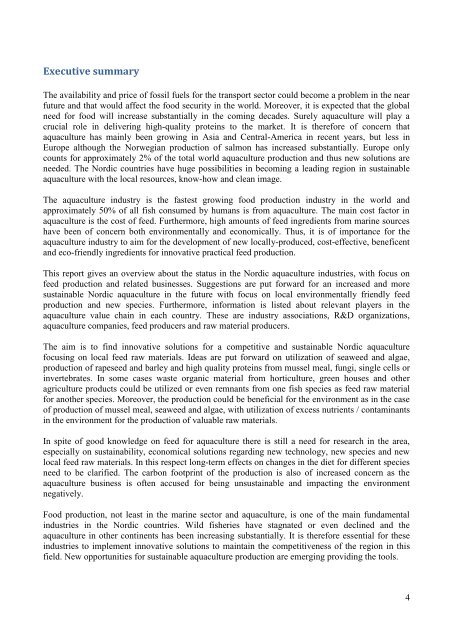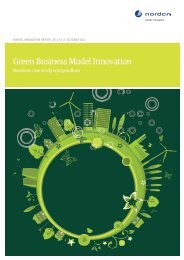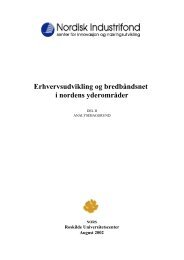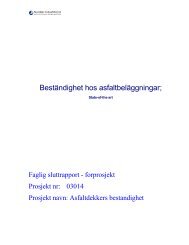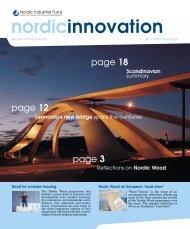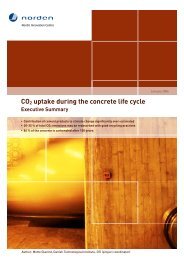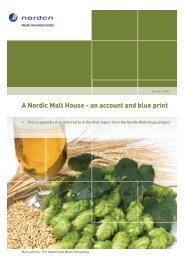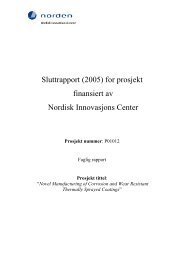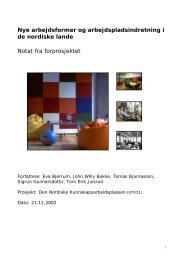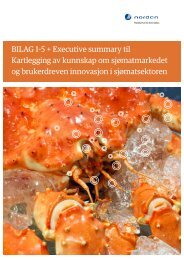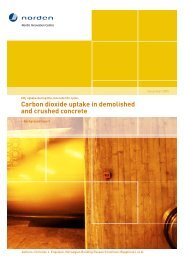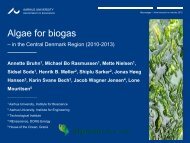Local raw materials for production of fish feed for ... - Nordic Innovation
Local raw materials for production of fish feed for ... - Nordic Innovation
Local raw materials for production of fish feed for ... - Nordic Innovation
You also want an ePaper? Increase the reach of your titles
YUMPU automatically turns print PDFs into web optimized ePapers that Google loves.
Executive summary<br />
The availability and price <strong>of</strong> fossil fuels <strong>for</strong> the transport sector could become a problem in the near<br />
future and that would affect the food security in the world. Moreover, it is expected that the global<br />
need <strong>for</strong> food will increase substantially in the coming decades. Surely aquaculture will play a<br />
crucial role in delivering high-quality proteins to the market. It is there<strong>for</strong>e <strong>of</strong> concern that<br />
aquaculture has mainly been growing in Asia and Central-America in recent years, but less in<br />
Europe although the Norwegian <strong>production</strong> <strong>of</strong> salmon has increased substantially. Europe only<br />
counts <strong>for</strong> approximately 2% <strong>of</strong> the total world aquaculture <strong>production</strong> and thus new solutions are<br />
needed. The <strong>Nordic</strong> countries have huge possibilities in becoming a leading region in sustainable<br />
aquaculture with the local resources, know-how and clean image.<br />
The aquaculture industry is the fastest growing food <strong>production</strong> industry in the world and<br />
approximately 50% <strong>of</strong> all <strong>fish</strong> consumed by humans is from aquaculture. The main cost factor in<br />
aquaculture is the cost <strong>of</strong> <strong>feed</strong>. Furthermore, high amounts <strong>of</strong> <strong>feed</strong> ingredients from marine sources<br />
have been <strong>of</strong> concern both environmentally and economically. Thus, it is <strong>of</strong> importance <strong>for</strong> the<br />
aquaculture industry to aim <strong>for</strong> the development <strong>of</strong> new locally-produced, cost-effective, beneficent<br />
and eco-friendly ingredients <strong>for</strong> innovative practical <strong>feed</strong> <strong>production</strong>.<br />
This report gives an overview about the status in the <strong>Nordic</strong> aquaculture industries, with focus on<br />
<strong>feed</strong> <strong>production</strong> and related businesses. Suggestions are put <strong>for</strong>ward <strong>for</strong> an increased and more<br />
sustainable <strong>Nordic</strong> aquaculture in the future with focus on local environmentally friendly <strong>feed</strong><br />
<strong>production</strong> and new species. Furthermore, in<strong>for</strong>mation is listed about relevant players in the<br />
aquaculture value chain in each country. These are industry associations, R&D organizations,<br />
aquaculture companies, <strong>feed</strong> producers and <strong>raw</strong> material producers.<br />
The aim is to find innovative solutions <strong>for</strong> a competitive and sustainable <strong>Nordic</strong> aquaculture<br />
focusing on local <strong>feed</strong> <strong>raw</strong> <strong>materials</strong>. Ideas are put <strong>for</strong>ward on utilization <strong>of</strong> seaweed and algae,<br />
<strong>production</strong> <strong>of</strong> rapeseed and barley and high quality proteins from mussel meal, fungi, single cells or<br />
invertebrates. In some cases waste organic material from horticulture, green houses and other<br />
agriculture products could be utilized or even remnants from one <strong>fish</strong> species as <strong>feed</strong> <strong>raw</strong> material<br />
<strong>for</strong> another species. Moreover, the <strong>production</strong> could be beneficial <strong>for</strong> the environment as in the case<br />
<strong>of</strong> <strong>production</strong> <strong>of</strong> mussel meal, seaweed and algae, with utilization <strong>of</strong> excess nutrients / contaminants<br />
in the environment <strong>for</strong> the <strong>production</strong> <strong>of</strong> valuable <strong>raw</strong> <strong>materials</strong>.<br />
In spite <strong>of</strong> good knowledge on <strong>feed</strong> <strong>for</strong> aquaculture there is still a need <strong>for</strong> research in the area,<br />
especially on sustainability, economical solutions regarding new technology, new species and new<br />
local <strong>feed</strong> <strong>raw</strong> <strong>materials</strong>. In this respect long-term effects on changes in the diet <strong>for</strong> different species<br />
need to be clarified. The carbon footprint <strong>of</strong> the <strong>production</strong> is also <strong>of</strong> increased concern as the<br />
aquaculture business is <strong>of</strong>ten accused <strong>for</strong> being unsustainable and impacting the environment<br />
negatively.<br />
Food <strong>production</strong>, not least in the marine sector and aquaculture, is one <strong>of</strong> the main fundamental<br />
industries in the <strong>Nordic</strong> countries. Wild <strong>fish</strong>eries have stagnated or even declined and the<br />
aquaculture in other continents has been increasing substantially. It is there<strong>for</strong>e essential <strong>for</strong> these<br />
industries to implement innovative solutions to maintain the competitiveness <strong>of</strong> the region in this<br />
field. New opportunities <strong>for</strong> sustainable aquaculture <strong>production</strong> are emerging providing the tools.<br />
4


